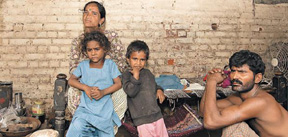 WASHINGTON: India accounted for the largest number of poor people in any country in 2012, but its poverty rate was lowest among countries having large number of poor population, a latest World Bank report has said.
WASHINGTON: India accounted for the largest number of poor people in any country in 2012, but its poverty rate was lowest among countries having large number of poor population, a latest World Bank report has said.
According to the report, the number of people living in extreme poverty around the world is likely to fall to under 10 per cent of the global population in 2015.
“India was home to the largest number of poor in 2012, but its poverty rate is one of the lowest among those countries with the largest number of poor,” the bank said.
Giving fresh evidence that a quarter-century-long sustained reduction in poverty is moving the world closer to the historic goal of ending poverty by 2030, it said a new methodology applied to household surveys in India suggests that its poverty rate could be even lower.
According to the report, the poverty rate in low-income countries averages 43 per cent in 2012, compared to 19 per cent in lower-middle-income countries. Yet lower middle-income countries are home to about half of the global poor, compared to a third for low-income countries.
Part of the reason is that four nations with the largest populations were once classified as low-income but have moved into lower-middle-income category: China, India, Indonesia and Nigeria.
Noting that connective infrastructure is a crucial means of linking the farms and firms where the poor live and work to markets, the bank said rural electrification in India has caused changes in consumption and earnings, with increase in the labor supply of both men and women, and promoted girls’ schooling by reallocating their time to tasks more conducive to school attendance.
Investment in integration and connectedness through railroads in India helped reduce the exposure of agricultural prices and real income to rainfall shocks, and helped diminish the famine and mortality risks associated with recurrent weather shocks, it said.
In its report, the bank uses an updated international poverty line of USD 1.9 a day, which incorporates new information on differences in the cost of living across countries.
The new line preserves the real purchasing power of the previous line (of USD 1.25 a day in 2005 prices) in the world’s poorest countries.
Using this new line (as well as new country-level data on living standards), the bank projects that global poverty will fall from 902 million people or 12.8 per cent of the global population in 2012 to 702 million people or 9.6 per cent of the global population this year.
“This is the best story in the world today – these projections show us that we are the first generation in human history that can end extreme poverty,” World Bank Group President Jim Yong Kim said.
Kim said the continued major reductions in poverty were due to strong growth rates in developing countries in recent years, investments in people’s education, health and social safety nets that helped keep people from falling back into poverty.
He, however, cautioned that with slowing global economic growth, and with many of the world’s remaining poor people living in fragile and conflict-affected states, and the considerable depth and breadth of remaining poverty, the goal to end extreme poverty remained a highly ambitious target.
“This new forecast of poverty falling into the single digits should give us new momentum and help us focus even more clearly on the most effective strategies to end extreme poverty. But it remains within our grasp, as long as our high aspirations are matched by country-led plans that help the still millions of people living in extreme poverty,” he said.
In its regional forecast for 2015, the WB said poverty in East Asia and the Pacific would fall to 4.1 per cent of its population, down from 7.2 per cent in 2012; Latin America and the Caribbean would fall to 5.6 per cent from 6.2 in 2012.
In South Asia, the poverty would fall to 13.5 per cent in 2015 compared to 18.8 per cent in 2012; Sub-Saharan Africa poverty would decline to 35.2 per cent in 2015 compared to 42.6 per cent in 2012.
“Development has been robust over the last two decades but the protracted global slowdown since the financial crisis of 2008, is beginning to cast its shadow on emerging economies,” said WB Chief Economist Kaushik Basu, a former Chief Economic Adviser to the Indian Government.
“There is some turbulence ahead. The economic growth outlook is less impressive for emerging economies in the near future, which will create new challenges in the fight to end poverty and attend to the needs of the vulnerable, especially those living at the bottom 40 per cent of their societies,” Basu added. -PTI





